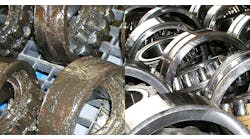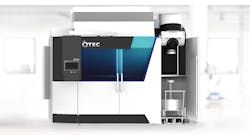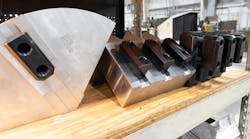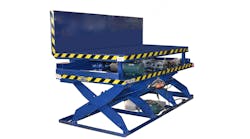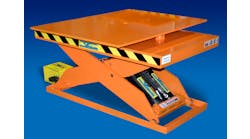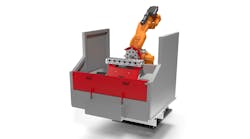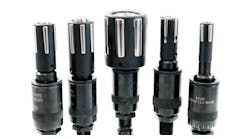Introducing collaborative robot (cobot) arms to work in the thyssenkrupp Bilstein plant in Hamilton, OH, was "revolutionary", according to Aldo Albieri the operations manager there. The plant is a high-volume manufacturer of high-tech automotive suspension systems. Volume production and reliable performance are a manufacturing priority there, as at so many manufacturing businesses. “I felt we were in the right time with the right opportunity to be part of it,” he said.
“We started seeing collaborative robots being used in a completely different way than we traditionally see six-axis robots running,” he continued, describing his visits to smaller machining operations where manufacturers with little or no robotics experience were automating even complex tasks with cobots. “They didn’t use safety caging and the cobots were placed on wheels and moved between tasks. That was when things really clicked,” he recalled. Since that time Albieri has overseen implementation of a new cobot every other month for almost two years.
“It happened at an incredibly fast pace with us, evolving rapidly from trial-and-error in the beginning, using vendors to do the machine integration,” he continued. Before long the Bilstein operators realized that in-sourcing the cobot deployments was a better way to proceed. The plant’s Industry 4.0 team managing the cobot applications investigated other options, but the manager noted that finally a decision was made to partner with one cobot supplier. “We realized that Universal Robots had the most advanced solution for more precise pick-and-place (functionality) … The cobot is easy to maintain and program, and it presents the best ratio of speed and repetition.”
Now Bilstein’s Industry 4.0 group has deployed nine UR10 cobots, the largest of the UR models with a 51-inch range and 22-lbs. payload. A tenth UR10 is used as a test model for future applications. “We are planning to implement about another forty cobot applications in our organization,” Albieri said, explaining that the company came up with a naming protocol for the new cobot colleagues. “We needed a system that could sequentially be applied to 45 to 50 cobots and decided to have some fun with it by naming them after U.S. presidents,” he said, smiling. The cobot fleet now extends from George Washington to John Tyler.
New avenue for growth, ROI — One eye-catching cobot application at the Hamilton plant features the James Monroe and John Quincy Adams cobots working in tandem to assemble thyssenkrupp’s Active Damping System (ADS) dampers. The multi-step cycle starts once Monroe picks up an innertube that it feeds to a punch machine and then places it on a transfer fixture, at which point J.Q. Adams picks it up and loads it into a “marriage station”, at which point the cobot grabs an outer-tube and marries the two together, then puts them on an exit chute. While trying to program the cobots to run in sequence with the machines being tended, the engineers made a novel discovery that eases deployment: they realized they could simply teach the cobots to push the start buttons on the machines instead of hardwiring the cobots into the control system.
Another task now automated is quality inspection, wherein four cobots conduct gauge inspection and check the post-fill crimp and final parts assembly.
“When we did the gauge inspection before, we would check two parts every one or two hours to make sure we were still where we thought (we should be), but now we have 100% inspection,” said Doug McIe, manufacturing engineer at thyssenkrupp Bilstein. The cobot deployed for the suspension components’ final assembly is equipped with a Cognex camera and moves swiftly between inspection points, to make sure that all components are in the right position and that the label is applied correctly and is readable. “Every single part that comes is checked and if it fails, the robot actually rejects it in the process,” he explained.
Since Bilstein started to bring the cobot automation in-house, the return on investment for the UR cobots has improved. “We have projects with both longer and shorter ROIs,” Albieri said, “but our comfort zone is a payback period of about 10-14 months to justify the investment. Cobots are definitely a quicker return of investment than traditional robots.”
Recently the plant also began testing two autonomous mobile robots from Mobile Industrial Robots (MiR) to supply material to the lines, performing the “no-value adding” handling of work materials between different production stations.
Freeing up labor to work on other tasks is a significant aspect of delivering the ROI quickly. “The UR cobots gave us the opportunity to grow, expand, and create more jobs, and move our most valuable resources— our human resources—into new projects, where the know-how was most needed,” Albieri said. He emphasized that growing the business in today’s labor market without cobots would be difficult. “If we relied only on hiring new people, we would never be able to expand the operation to three times the original size, as we have done. The cobots have opened a new avenue of growth for us, while we’ve been able to retain our existing workforce. No worker will lose his or her job to a robot.”
Involve the operators — While Bilstein continues to use traditional automation for fast-paced cycles in enclosed spaces, now the strategy is to have the cobots take over tasks for which workers define opportunities. Jordan Osterholt, process engineer in the operation’s Industry 4.0 group, explained that it is critical to involve the operators in pinpointing jobs that offer new opportunities for collaborative automation. “Operators are at the forefront of all the building that goes on in this company,” he said. “Asking them — ‘Where can we help you to improve the process?’ — has been very useful for us when we develop new applications.”
According to Albieri, implementing cobots is not just a technology adventure for the auto parts manufacturer. “It’s really about implementing a new organization with transparency and open communication. You don’t want employees coming into work one day, realizing they have a robot working next to them,” explained the Bilstein operations manager, who made sure the first UR cobots were introduced in front of the shop floor team before deployment.
“We explained that these cobots were here to expand our business and help remove repetitive ergonomic issues, and working conditions that are not the most favorable to people. And that has been the absolutely reality,” he said, referring to the influence of the cobots’ collaborative nature.
“There is not such a big barrier between the people and the technology now,” Albieri emphasized. “The cobots share the workspace with our employees, who can simply grab the intuitive teach pendant and operate the cobots as the interface looks more like an iPad than a robot controller.”
Machine operator Quenna Quarles, who used to perform some tasks that now are automated, welcomed the cobot coworkers. “I had a lot of aches and pains in the past, constantly having to physically punch that, move this,” she said. “Now we can flow much better, production-wise, and my job is easier as I just load the tubes and let the cobots take care of the rest.”
The engineering team developing the cobot applications did not have any prior robotics experience. “We started by doing simple pick-and-place tasks to get the ball rolling,” McIe said. “Next was figuring out the interface with the machines; it was a bit harder, but once we got it done, it spread really quickly and we started seeing applications all over the plant that we could almost copy-and-paste the implementation sequence.”
Jordan Osterholt explained how going through the UR Academy free, online training modules had been instrumental during the developing phase. “I would do the tour of how to program the robot, and walk straight over to our test robot and apply what I learned,” he said.
The demo robot is on wheels so it can simply be rolled up machine-side to test a task. “We can plug the cobot into a regular, 110-Volt outlet and start testing right away,” explained McIe. “With a traditional industrial robot, we would first have to drill holes and bolt it to the floor. This saves us a lot of time.” In addition to deploying a test robot to develop new applications, Bilstein also uses the RoboDK software, certified through the UR+ platform to be plug-and-play with UR cobots. “The software simulations really help us to figure out if our cycle time is going to be accurate enough that it’s worth prototyping the tooling and getting it out there,” said McIe. “We can put in the effort on the computer screen, and when we deliver it. It’s almost ready to go.”
Now the Industry 4.0 team is working to invert two UR10 cobots on a UR+ certified, seventh-axis range extender developed by Vention, and plans to continue the fast-paced rollout, introducing a new cobot on the shop floor every other month. “There are just so many opportunities out there,” concluded Albieri. “The sky is the limit.”


